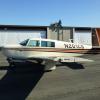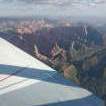-
Posts
2,358 -
Joined
-
Last visited
-
Days Won
4
Bob - S50 last won the day on July 27 2020
Bob - S50 had the most liked content!
Contact Methods
-
MSN
bobpatch5@msn.com
Profile Information
-
Gender
Male
-
Location
S50 - Auburn, WA
-
Reg #
N4930V
-
Model
2004 SR22
Recent Profile Visitors
8,075 profile views
Bob - S50's Achievements
-
Depends on how many screens you have that can display information but among my favorites are: Groundspeed Distance to destination Distance to next fix Vertical speed required (if I don't have an autopilot that does VNAV) ETE to destination. We have dual GTN650's. We leave one set to the Flightplan page and one set to the Map page. Because of that, we have the field on the far right, just below the standby frequency window, set to page buttons that take us directly to the FP/Map page respectively. That way, if we navigate away from our usual page for some reason (find a nearest for example, or loading an approach) we can get back to the usual page with a single touch.
-
I'm going to say something different than everybody else. When I first started flying the Mooney, I had problems with crosswind takeoffs too. I found them harder than crosswind landings. I was using the same technique I was used to using in the heavy metal, that is, forward pressure on the yoke to keep weight on the nosewheel. I found that to be a bad technique for the Mooney. The reason was that our M20J sat with the wing at a pretty high angle of incidence while on the ground. That results in the wing producing significant lift as I approached takeoff speed. By pushing on the yoke, I actually made things worse because I was holding the nose down, I was producing lift on the tail, the mains would lift off before the nose, and I would find myself wheel-barreling down the runway with nothing to keep me from weather veining into the wind. As a matter of fact, if you search the internet hard enough for belly mounted videos of Mooney takeoffs, you'll find some that show the mains getting airborne before the nose. Instead, I switched to pulling back on the yoke. That put down pressure on the tail and helped keep the mains on the runway. By the time the nose got light, the rudder was effective for directional control, and shortly thereafter the plane was ready to fly. And of course, the standard aileron into the wind too.
-

GTN tracks 500 feet right of centerline
Bob - S50 replied to Jim Peace's topic in Avionics/Panel Discussion
Don't know if it's the same issue or not, but a pilot on the COPA forum noticed the same issue with his brand autopilot (don't remember what brand). Turned out to be a yaw issue. Once he adjusted the airplane so it flew without any yaw, the AP tracked exactly on course. -
But here is the reality of the situation: However, keep in mind that those graphs may be misleading if they show actual number of accidents rather than accident rates per aircraft in each category. For example, if I start with 200 aircraft and 60 of them have an engine failure in the first 500 hours of life, there are now only 140 aircraft left while the 60 that had the problem and got fixed go back into the pool with less than 500 hours. If 40 of the 140 that have 500 - 1000 hours have an engine failure, there are now only 100 aircraft left to continue while the 40 get fixed and go back into the pool of under 500 hours. As you continue along with that logic, there are fewer and fewer aircraft actually flying that reach those higher hourly totals. That, by itself, will reduce the number of engine failures. And each one that does fail and gets repaired goes back into the 0 to 500 hour pool. Many of those engines may never fail because they get pulled and overhauled and then go back into the 0 - 500 hours pool. If those graphs showed failures/number of aircraft meeting the criteria, I think the graph would be much less skewed. That of course means that while we may not need to pull engines early for an overhaul, it also means an engine may fail at any time and we must always be prepared.
-
It's not the name on the door that makes a difference, it's the people inside that make the difference. The name that used to be great may not be so after the owner retires and sells the shop. Like a wife or husband, it's sometimes hard to find a good mechanic. But once you do, never be the one responsible for ending that relationship.
-
I'll take a stab at it. For stability you always want the front surface to stall before the aft surface. That means you will get maximum lift out of the front surface and less than max out of the rear. With a canard you are getting max performance out of the small surface and less than optimum out of the big wing. With a conventional configuration you max out the big wing and sacrifice a little on the aft wing.
-
Which we should all take as a compliment.
-
I must be really boring. I don't do anything other than flight related tasks or checking with my passengers. On long flights I print out a flight log. For me, I find the one on SkyVector most nearly approximates the information I would print if I had total control. The one on 1-800-WxBrief is not to my liking even though I've asked them several times to allow each pilot to roll their own. At waypoints about 20 minutes apart I record the time and fuel and compare it with the projection. I then record the difference as either plus or minus some value for each (just like we did at the airlines). After two or three points you can start to detect a trend of coming up short on fuel or making fuel. Between that, listening to ATC, checking weather ahead with ADS-B IN, checking engine instruments, trying to spot traffic I see on ADS-B, and enjoying the view; that's enough for me.
-
I'm able and willing to wait and see rather than speculate doomsday.
-
He has said he expects about a $.60 to $.80/gallon increase, not $2.00. Price in my area is already closer to $6/gallon in my area.
-
To cover the cost of development and make a profit. All the engines and equipment he has bought for testing. All the fuel and chemicals he's bought for testing. All the man hours paid for during testing. Don't begrudge the man for making money. He may have just saved our planes by making a fuel available for us before the environmentalists shut down the production of 100LL without an alternative. If we all think he is making so much money, we could have been the ones who spent 100's of thousands of dollars in development for something that might have never paid off. But we didn't. He did. Just like those guys at Microsoft and Apple that gave us the computers we now have. Or the guy that brought us Amazon for easy shopping. Or the guys that developed cell phones. Or microwaves. Or television. Or....
-
From what I can tell, as long as you use self serve, nothing would physically prevent someone from using the UL without buying the STC. If you want the FBO to pump your gas, they will likely refuse if they don't see the decals that come with the STC. Assuming you only use self serve, nothing would happen until something did. Like being ramp checked or being involved in a reportable incident and they find out what you've been doing. I'm guessing the FAA would likely view that as an intentional violation and yank your license. It will cost a lot more to get the license back than you would save in STC cost. Do you feel lucky?
-
Lead is bad for everybody. We should be glad we can get rid of it. It costs me roughly $100/hour in operating expenses to fly my plane. The increased cost of fuel will bring that up to roughly $110 - $115/hour. That's 'only' a 10 - 15% increase in cost. It has a bit higher energy content. I've heard something between 1.5 and 3% more. That brings my cost increase down to something around 7 - 13.5%. I will be able to use a synthetic oil (once they start making it again) which will reduce friction and make my engine last longer. That will reduce costs for me. I'll also be able to use extended drain intervals to more than offset the higher cost of the synthetic oil. I won't get lead deposits in the engine which will reduce maintenance costs and increase reliability. As far as I know, there is only one producer of TEL in the world. If something happened to that plant we would all be grounded for lack of fuel. Without the lead, production and transport becomes easier which translates to cheaper and more dependable as opposed to our current shortage because they can't find enough drivers that can carry hazardous material. I've heard the STC will cost between $1 and $2/HP, so roughly $200 to $600 for most of us. If you can't afford an extra $8/hour to fly the plane, you should probably sell the plane to someone who can.
-

Looking for pirep for Surefly on IO550
Bob - S50 replied to Mufflerbearing's topic in Modern Mooney Discussion
I was not aware of a dual SureFly installation. I do know that EMag is working on a dual electronic ignition installation with a pie in the sky hope for next spring sometime. Their system is different in that each EMag has a built in alternator to supply its own power as long as the engine is rotating above some minimum speed. I want to say 600 RPM, but don't quote me. You only need the battery to start. As for COPA, yes, people are reporting problems with the SureFly if they do not install the power regulator/conditioner. Works great once the regulator is installed. Interestingly, even though the Lycoming electronic ignition is a rebranded SureFly, Lycoming does not offer the regulator that is needed for 24 volt systems. And since the label says Lycoming, SureFly cannot sell you their regulator for use with a Lycoming ignition system. They can only sell it for the SureFly system.




